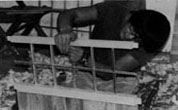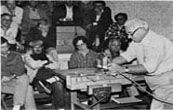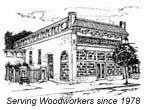|
||||||||
|
|
||||||||
|
|
The following article was originally published in Wood News No. 16, Fall 1985. Hustling Wood by Wallace Macfarlane TREEN: Made of 'tree'; wooden. Of or belonging to a tree or trees; in quot. 1670, obtained or made from trees. Oxford English Dictionary. When you start making treen, it doesn't take too long to find out you need more wood. If you make flat things like a cutting board or Lazy Susan, you can buy what you need. One trouble with turned objects is that wood from a lumber yard or specialty store is expensive. Worse, expensive wood ensures a mind-set that you can't afford to experiment, that you'd better hold your breath, not wiggle, and be perfect. With only a single pretty piece of walnut, apprehension can outweigh pleasure, and if you screw things up as I often do, you can get severely bitten in the pocketbook. A further consideration is the size of wood you can buy. One-by and two-by means that you must laminate to make a big bowl. You can do tricky stuff like gluing purpleheart veneer between pieces of ash to make a striking display, but unless this sort of detail is where you find your jollies, the time spent and the out-of-pocket cost is high. Not to mention the whole world of gluing procedures and how I always need one more clamp than I've got. And one more hand. All objects have a proper size. If I want a box to hold cookies, available dimensioned lumber like Douglas fir 4 X 4's and 6 X 6's won't make it. Who needs to turn a boxful of cracks? Who needs a cookie tasting like Doug fir? While you can chop a cottage from a redwood, in real life a two-foot diameter tree is as big as I need. I've seen pictures of polyethylene glycol-ed bowls with a kid inside. They're remarkable as the Lord's Prayer written on the head of a pin, a difficult and amazing accomplishment, but not something I need to do. Of course it comes down to what you enjoy doing. If you like to work with finished wood and find romance in ebony and padouk and koa, I can appreciate your work and cheer you on, but it's not for me. Don't misunderstand. I like zebrawood and wenge as well as the next man, but I take as much pleasure in mesquite and Monterey cypress. There is also the lagniappe of surprise in the most ordinary wood. I once turned a box lid from peach, just beautiful with a strongly patterned pinky-orange color, and ever since I've been looking for another piece of peach that's not cracked or gone-to-hell in general. Right now I have some logs of yellow pine with heavy red-brown heartwood and thick pale yellow sapwood with orange-brown rings. Quite handsome, but the occasional buried pitch pocket puts adventure back into turning a bowl. Some sections weep for no obvious reason. A friend told me that anything will dry sometime and Charlie Chan said "Patience are a very lovely virtue", and this all goes to convince me that ordinary wood can be exciting. After I rummaged through the wood pile for turning stock and made a lot of leftovers and sawdust, I figured out that if I was going to make treen for fun and profit, I would have to hustle my own wood. Curiously enough, a big part of the hustle was to establish a philosophic stance that let me enjoy a 40-mile trip for some Chinese elm that ended up as firewood six months later. If I didn't have a fireplace, I would probably be less philosophical about it. But it was a splendid summer day with thunderheads, the beer bar had a most memorable sausage out of a jar (simply awful but that's about all they had to eat), and the proprietor was as flavorful and tangy as the sausage she sold. Chinese elm can be a delightful wood, hard and water satin patterned with an intriguing chatoyancy, but the logs I got had begun to split and as it turned out, there was no way I could save them. But oh, the taste of that sausage washed away with beer! A first class day. A fireplace is high on a list of important things if you are going to hustle your own wood. It's also very useful in my general shop practice. The promising bowl that came apart on the lathe, that bark intrusion that never quit, the disasterous mis-measurement, the hidden rot, the time I got carried away artistically and made a candlestick that on later consideration looked exactly like a pile of petrified dog poop: all these misadventures, in the last analysis, will keep me warm. Another fundamental premise for me is to make a nickel. It's part of keeping score and knowing where it's at. There are a great many things I could do to make more money, but even considering the perquisite entertainment in originating treen, I'd like to make at least minimum wage. Sometimes I make a great deal more and sometimes I put more labor into an item than is reasonable. I made some elegant spinning tops and sold them at what seemed to be a ridiculously high price and figured out I was making maybe a dollar an hour. I made some more tops to reconsider my production methods and gave them away to friends. It's got to be maybe-yes, maybe-no to make cutting boards when anybody can buy very nice ones for half of what I charge and don't make minimum wage on. But I can use pretty wood that might otherwise be wasted, dark and light strips of apple glued and doweled and elegant. Customers call them chessboards and keep them in a glass cupboard most of the time. People from New York and Washington, DC and Chicago and San Francisco have assured me my prices are modest. They tell me this after they've paid for the box or bowl. It doesn't have to be a comment on my stupidity. I take it for a compliment on my belief that it is better to sell something than keep it on the shelf, and it's also nice to give the cognoscenti and hoi polloi a perceived bargain. I don't have to make a living at treen, but granted a lot of preconditions, I think it's possible to do so. In pursuit of wood, authorities mention loggers and sawmills and the pioneering phase of construction jobs as sources. They suggest following the siren song the distant chainsaw sings. There are no loggers or sawmills where I live and construction crews mostly take out live oak. In any warp-wane-wander-check-split contest, live oak is a top contender. It took me three years to cure some live oak for single-piece Lazy Susans and six months of trepidation to see if they would be stable even then. The wood ended up dark, dark brown, ray-flecked and handsome, but it will be a long time before I talk myself into trying it again. In other circumstances, I have thought it might be a good idea to cozy up to the local park department, the power company, the city street maintenance folks, the man who keeps a woodyard and sells firewood, and the various tree service people in the yellow pages. I suspect there are as many ways to find wood as people looking for it: I heard of a man who gets myrtle which washed into the ocean and cast up on Oregon beaches. He uses carbide-tip chains and saws a lot of sand, but there is no such thing as a free lunch. There is no pie in the sky either, though every once in a while somebody will bring you a piece of wood that is unexpectedly gorgeous. About 90% of the time your goodhearted but chuckleheaded donor brings a wormy chunk of checked oak, or splintered cedar or elderly ash. Because I like to encourage donations, they get back at least a darning egg even though that's the only piece in the log. Sometimes you are promised a tree and it turnes out to be a dead pine thirty feet tall in a six-foot space between a garage and fence, with a power line ten feet away and a hound of the Baskervilles commenting on your work in the next yard. Then the wood is blue and beetle-ridden. Such an experience is better than a bottle of smart pills. You learn to be judicious about the next tree. Even smart enough to look before you promise. But keep an open mind. The world is organized so the pure in heart get their rewards, and me too. One time the next tree was an old apricot from which I turned $300-plus worth of glorious treen. If you were to give me just one tree, I would take apricot, thanks. It is pretty, pretty wood and nice to work besides. Wood is the same as they used to say about whiskey: some kinds are better than others. I got hold of a bunch of Western sycamore that was all fiber and pith, just as nice to work as a palm tree might be. It mildewed when I tried to dry it under plastic. When I finally turned it, it stank. You are better off leaving it alone. I suppose there's whiskey like that. And yet one piece of dry sycamore made a respectable bowl. (The next dry piece didn't). If it comes my way again maybe I'll have another drink - I mean there's probably a lot more for me to learn about that wood. With sycamore at the bottom of the list, I've turned treen from everything I could lay my hands on. Coulter pine is a good example. It was used for firewood and pit props in mines where it rotted as quickly as it could. The wood is light, coarse-grained and soft. Cut into lumber to meet a shortage during the second world war, you had to nail it the day after it was sawed - when dry, not one stick in a hundred would stay flat. So I had a poor opinion of Coulter pine until a friend said he had some trees down in a high wind and would I like? I took my chainsaw and got some logs which I turned into big bowls that ended up bright, light and handsome with tight translucent knots, very nice indeed. I was not able to maintain any inventory because people bought them when they saw them. The next time I got a bunch of Coulter pine it had a coarser grain and darker yellow wood. The time after that the wood blued due to the action of decay fungi. I have learned to avoid working any stained pine, though when turned to an Indian-looking pot or bowl, people will buy them, though not with the eagerness they show toward my breadmaking Coulter pine bowls. A traveling sawmill fifty miles away cut up/cut down a walnut grove and for an encore I suppose, made lumber out of the windbreak cottonwoods along one edge. A commuting friend brought home several truckloads of slash for firewood and sticked and stacked the rest. The walnut was English walnut grafted onto the disease-resistant black walnut stock. It's nice enough, with a gray cast - I got some of that and it was okay. The surprise was the air-dried cottonwood: light, soft, straight-grained with pin knots in colors from light tan to beige to light brown. I am charmed by the wood. I made some very short rolling pins and called them "The Chuck Wagon Model". Thet sold after a while, but bowls and boxes made of the same thing sold more slowly. I think cottonwood is historic, the wood of the covered wagons on the great plains, the only source of fuel aside from buffalo chips, and the only shade anywhere in Kansas. If you cut off sticks for a fence, they sprout to a wall of cottonwoods. Just because buyers are not equally charmed is too bad, but I'll look for more cottonwood. Plum is a wood I'd like to know better. The Santa Rosa tree I cut up was a reddish brown with some nice purple streaking and about as dense as a garden grown cherry. I've had good luck curing almond, but poor luck with peach and nectarine. Pear is a pleasant, stable wood, fine-grained and tractable, but not spectacular except when you find dead wood along one side or are lucky enough to catch spalted pear before the deacy has gone too far. Apple can be a splendid wood with clouded mysterious figuring in the best pieces although the grain twists vertically and the trees are subject to borers. Mulberry is a prominently-grained rich yellow that tends to darken as the treen is exposed to light. All the citrus woods are fine-grained and light in color, very pleasant wood to turn, and I cannot distinguish between grapefruit and orange and lemon and kumquat, or I suspect, any of the other citrus I've not worked. Avocado is wondefully variable, light and stable, ranging in color from bland cream when newly cut, to a grey quite like laurel, to highly-figured greys almost to a dramatic black. Guava is a shrub, but you get pieces large enough to make attractive pink-gray knobs, dibbles and dowels, Apricot is patterened with orange-yellow-brown coloration, attractive to me and to customers who snatch it away. Twenty years ago I got some cherry from a Royal Anne tree cut fifty years before that and stored in a barn. It is delightful with all the rose and lavender and even green shadings I didn't know about at all. I think I am spoiled for ordinary cherry, but I'd like to see. Olive is another wood that differs from tree to tree. What I've had to turn is nondescript, but the common-enough burls could be interesting and I've seen pictures that make me want to try again. I was bored with Oregon myrtle until a friend from Bandon brought a half-a-dozen six-foot slabs and the color and patterning were outstanding. I made beautiful Lazy Susans and zap, they were sold! We have old locusts around and I've sawed down a bunch. I cured some 6"-thick rounds two feet in diameter and they made spectacular chopping blocks. Ols air-dried-on-the-vine locust can be extremely hard. I cut an 18" tree growing in a cienega that turned out to be as tough as pine. Black willow is described as "a low density hardwood" and the few pieces I've had to work made good-looking bowls. This inventory is a long way from being complete, but it will indicate the utility and beauty I've found in almost every tree I've come across. Making treen does not require exotic wood. It does take a lot of wood. I have a four-foot loading dock outside my shop door, and ten months ago I started shoving the sawdust over the edge instead of carting it away. I now have a mound level with the dock for three to four feet before it ramps gently down to the yellow pine and eucalyptus logs awaiting attention. I've been putting in half a day playing with wood, and that's even more sawdust than I expected in the normal course of events. There are boxes and boxes of kindling of course, bark and ends and slices and mistakes and face plates. How do I get all this wood? I think the most important one source in hustling wood is friends. I can saw my own apple and some oak and locust and others, but I'll get a phone call from Les Ecklund about pear, or Marty Sather about black acacia and incense cedar, or Dick White about whit oak (what else?), or Woody Barnes about manzanita, or Dick Davis about ironwood from the desert, or Gerda Bennett about apricot. Friends are even more important than a chainsaw. No chainsaw ever gave me wood or told me a joke or bought me a drink. About the theatre Noel Coward said, "Speak clearly and don't bump into people." About writing Raymond Chandler advised, "Doublespace and leave an inch margin." About racing at Indianapolis Bill Vukovich said, "Turn left and step on the gas." About making treen, I can give equally valuable advice to put on a bumper sticker or tattoo on your heart: Get hold of some wood, crank up your lathe, and give it a whirl.
|
|



